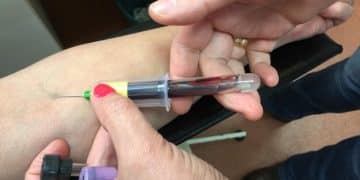US Government Grants: A 2025 Guide to Innovation Funding

Insider’s Guide: Leveraging US Government Grants for Small Business Innovation in 2025 explores how small businesses can strategically access and utilize government grants to fuel innovative projects and growth in the coming year.
Navigating the landscape of government funding can be challenging, especially for small businesses aiming to drive innovation. This Insider’s Guide: Leveraging US Government Grants for Small Business Innovation in 2025 offers a detailed roadmap to help you unlock these opportunities and propel your business forward.
Understanding the Landscape of US Government Grants for Small Businesses
The US government offers a wide array of grant programs designed to support small business innovation. Understanding the types of grants available, the agencies that administer them, and the eligibility criteria is the first crucial step.
Types of Grants Available
Grants can be broadly categorized into several types, each serving different purposes and industries.
- Small Business Innovation Research (SBIR) Program: Funds early-stage research and development (R&D) projects with commercialization potential.
- Small Business Technology Transfer (STTR) Program: Similar to SBIR but requires partnerships between small businesses and research institutions.
- Economic Development Administration (EDA) Grants: Supports projects that foster job creation and economic growth in distressed communities.
- National Institutes of Health (NIH) Grants: Funds health-related research and development projects.
These are just a few examples, and there are many other grant programs that may be relevant to your specific industry and project.

Identifying the right grant for your project involves researching available programs, understanding their specific goals, and assessing your alignment with their priorities. Careful selection is crucial for increasing your chances of success.
In conclusion, understanding the types of grants available and aligning them with your business goals is the foundation for a successful grant application strategy. The next step involves identifying the key agencies that offer these grants and understanding their specific priorities.
Key Government Agencies Offering Innovation Grants
Several key government agencies play a significant role in providing grants for small business innovation. Knowing which agencies align with your business sector is crucial.
Small Business Administration (SBA)
The SBA is a central hub for small business resources, including information on grant opportunities. While the SBA doesn’t directly offer many grants, it provides resources and assistance to help small businesses navigate the grant landscape.
National Science Foundation (NSF)
The NSF supports fundamental research and education in all fields of science and engineering. Its SBIR/STTR programs are particularly valuable for tech startups.
Department of Energy (DOE)
The DOE offers grants for projects focused on energy efficiency, renewable energy, and other energy-related innovations.
- Advanced Research Projects Agency-Energy (ARPA-E): Funds high-risk, high-reward energy technology projects.
- Office of Energy Efficiency and Renewable Energy (EERE): Offers grants for renewable energy and energy efficiency projects.
- Fossil Energy and Carbon Management: Focuses on advancing technologies to reduce emissions from fossil fuels.
Each agency has its specific focus areas and priorities. Understanding these nuances is key to tailoring your application effectively.
In summary, identifying the right government agency to target for your grant application involves understanding their specific focus areas, priorities, and funding opportunities. Aligning your project with the agency’s mission is crucial for increasing your chances of success.
Preparing a Compelling Grant Application
Crafting a compelling grant application is essential for securing funding. A well-structured and persuasive application demonstrates your project’s value and potential impact.
Understanding the Application Requirements
Each grant program has specific application requirements, including forms, deadlines, and supporting documentation. Careful attention to detail is essential.
Writing a Clear and Concise Proposal
Your proposal should clearly articulate your project’s goals, methodology, and expected outcomes. Use clear, concise language and avoid technical jargon.

- Executive Summary: A brief overview of your project, highlighting its key benefits and impact.
- Project Description: A detailed explanation of your project’s goals, methodology, and timeline.
- Budget Justification: A breakdown of your project’s costs, with clear justification for each item.
A well-written proposal should demonstrate a clear understanding of the problem you are addressing, the innovative solution you are proposing, and the potential impact of your project.
In conclusion, preparing a compelling grant application requires careful attention to detail, a clear and concise proposal, and a strong understanding of the funding agency’s priorities. With a well-crafted application, you can demonstrate your project’s value and potential impact, increasing your chances of securing funding.
Strategies for Maximizing Your Chances of Success
Securing a government grant is a competitive process. Implementing strategic approaches can significantly increase your chances of success.
Building Partnerships
Collaborating with other organizations can strengthen your application and demonstrate your project’s credibility. Consider partnering with universities, research institutions, or other businesses.
Seeking Expert Advice
Consulting with grant writing experts can provide valuable insights and guidance. These experts can help you refine your proposal and ensure it meets the funding agency’s requirements.
- Grant Writing Workshops: Attend workshops to learn best practices in grant writing.
- Consultants: Hire a consultant to review and provide feedback on your application.
- Mentors: Seek guidance from experienced entrepreneurs who have successfully secured grants.
By leveraging partnerships and seeking expert advice, you can significantly enhance the quality and competitiveness of your grant application.
In summary, maximizing your chances of success in securing a government grant involves building strategic partnerships, seeking expert advice, and continuously refining your proposal based on feedback and insights. These efforts can significantly improve the quality and competitiveness of your application.
Navigating the Grant Application Process in 2025
The grant application process is constantly evolving, with new technologies and platforms emerging. Staying informed about the latest trends and best practices is essential.
Online Application Platforms
Most government agencies now use online platforms for grant applications. Familiarize yourself with these platforms and ensure you have the necessary technical skills to navigate them effectively.
Utilizing AI and Machine Learning
AI and machine learning tools can assist with grant writing by providing feedback on your proposal, identifying potential gaps, and suggesting improvements.
Understanding the evolving landscape of the grant application process and leveraging new technologies can streamline your efforts and improve your chances of success.
In conclusion, navigating the grant application process in 2025 requires staying informed about the latest trends, utilizing online application platforms effectively, and leveraging AI and machine learning tools to enhance your proposal. By embracing these strategies, you can streamline your application process and increase your chances of securing funding.
Common Pitfalls to Avoid in Grant Applications
Many grant applications are rejected due to common mistakes. Avoiding these pitfalls can significantly improve your chances of success.
Lack of Clarity
Ensure your proposal is clear, concise, and easy to understand. Avoid technical jargon and clearly articulate your project’s goals and objectives.
Insufficient Budget Justification
Provide a detailed budget justification that clearly explains the costs associated with your project. Ensure your budget is realistic and aligned with your project’s scope.
- Unrealistic Budget: Make sure your budget aligns with project scope.
- Missing Information: Ensure all required documents are attached.
- Not Following Instructions: Adhere to all guidelines.
By avoiding these common pitfalls, you can significantly increase the chances of your grant application being seriously considered.
In summary, avoiding common pitfalls in grant applications, such as lack of clarity, insufficient budget justification, and failure to follow instructions, is crucial for increasing your chances of success. By ensuring your proposal is well-written, well-justified, and meets all requirements, you can demonstrate your project’s value and potential impact.
| Key Point | Brief Description |
|---|---|
| 💡 Grant Types | SBIR, STTR, EDA, and NIH are some of the available grant types. |
| 🏛️ Key Agencies | SBA, NSF, and DOE offer significant innovation funding. |
| ✍️ Application Tips | Ensure clarity and a well-justified budget in your proposal. |
| 🤝 Partnerships | Collaborate with universities and experts to strengthen your application. |
Frequently Asked Questions
▼
The Small Business Innovation Research (SBIR) program aims to fund early-stage research and development projects carried out by small businesses that have significant potential for commercialization.
▼
While not directly offering many grants, the Small Business Administration (SBA) provides extensive resources like workshops and counseling to help small businesses effectively navigate the grant application process.
▼
A budget justification should include a detailed breakdown of all project costs, explained clearly and logically, with each expense aligned with the project’s objectives and scope. It’s key to show why each item is necessary.
▼
The National Science Foundation (NSF) primarily focuses on funding research and education projects across all fields of science and engineering, with a strong emphasis on innovative and transformative ideas.
▼
AI tools can support grant writing by assessing the strength of your proposal, identifying gaps in your arguments, and suggesting content improvements, which helps in creating a more robust and competitive application.
Conclusion
Securing US Government Grants for small business innovation in 2025 requires a strategic approach, thorough preparation, and a clear understanding of the funding landscape. By following this insider’s guide, you can maximize your chances of success and unlock the resources needed to drive your business forward.





